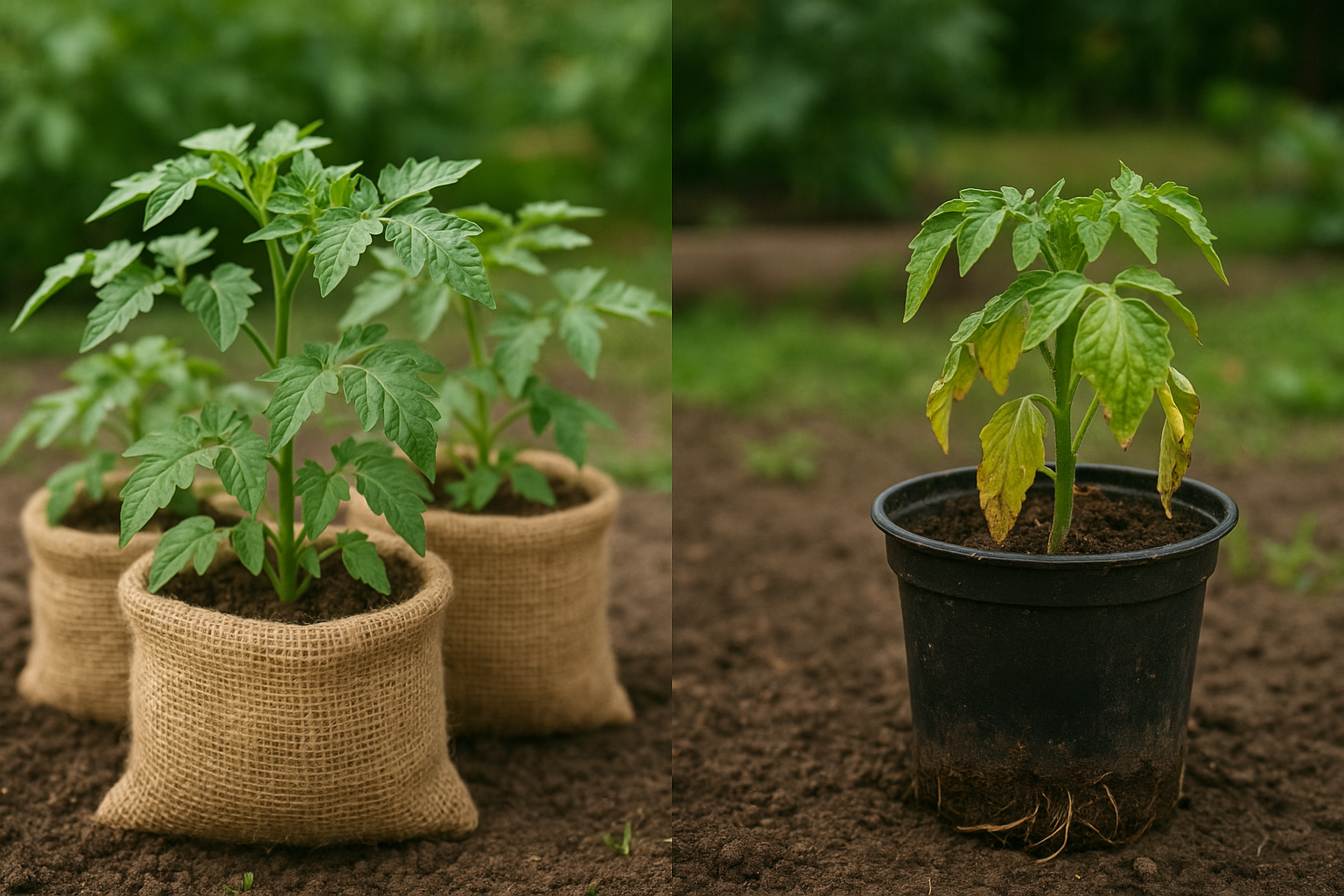- May 25, 2025
- Posted by: wellcoindustries
- Categories: Burlap, Erosion Control
Introduction
Shifting from plastic to natural fibers is no longer just a trend—it is a performance decision. Purchasing managers who specify planting and shipping materials must meet aggressive sustainability goals and deliver healthy, sale‑ready plants. Burlap sacks for gardening solve both sides of the equation: the loosely woven jute fabric “breathes,” protecting delicate root systems, and then biodegrades at the end of its service life.
Wellco Industries, a vertically integrated supplier of fiber‑reinforced composites and agricultural consumables, has shipped millions of burlap grow sacks and erosion‑control fabrics worldwide. Drawing on that field experience, this guide explains why professionals are replacing conventional plastic bags with burlap alternatives—and how to specify them with confidence.

The Material Difference: Burlap vs. Plastic
Breathability & Root Health
Roots need oxygen as much as they need water. Laboratory trials published by the USDA’s Agricultural Research Service found that vegetable transplants wrapped in burlap experienced 20 % less damping‑off disease compared with seedlings kept in sealed polyethylene sleeves. The open weave releases excess moisture and heat, preventing the anaerobic conditions that invite pathogens.
“Since switching to jute grow sacks, we’ve virtually eliminated root rot in our plug trays,” reports the propagation manager of a 700‑acre greenhouse operation in Ontario.
Sustainability & End‑of‑Life Impact
Plastic mulch and carry bags can linger in soil for up to four centuries before breaking down into micro‑plastics. By contrast, an uncoated jute sack decomposes in six to nine months under typical composting conditions, returning lignin‑rich organic matter to the substrate. Life‑cycle analysis conducted by an independent consultancy placed the total carbon footprint of a medium burlap sack at 60 % lower than an equivalent‑volume LDPE bag when manufacturing, transport, and disposal were included.
Real‑World Performance in the Field
Case Study: Midwest Nursery Transplant Program
A large tree nursery in the U.S. Midwest piloted burlap‑wrapped root balls for fall digging. Out of 2,400 sugar maples transplanted, first‑year survival reached 93 %, a 15‑point improvement over the previous season’s plastic‑lined wire baskets. Operators credit the sacks’ wicking action, which keeps the root ball uniformly moist during transport while still venting excess water.
Erosion‑Control & Soil Conservation Applications
Departments of Transportation often need quick, temporary sandbags to redirect stormwater on job sites. A regional contractor noted that 30 % fewer man‑hours were required when crews filled biodegradable burlap sacks instead of woven‑poly bags, because the lighter fabric is easier to handle and ties securely without specialized clips. The sacks can be slit and tilled directly into the verge after the project, eliminating a second trip for removal.
Procurement & Quality Considerations for Pros
Specifying Weight, Weave, and Treatment
Not all burlap is equal. For container crops, look for fabric weights between 9 and 12 oz/yd² (305–407 gsm); this balance delivers structure without hindering airflow. High‑sun regions may benefit from a light food‑grade UV treatment that doubles outdoor service life. Food‑processing clients occasionally request hydrocarbon‑free finishing to meet FDA contact standards.
Sourcing & OEM/Private Label Opportunities
Vertically integrated partners such as Wellco Industries weave, cut, sew, and palletize in‑house, shortening lead times and tightening quality control. Contractors can order custom sizes—anything from 10 × 14 in. seedling pouches to 48‑in. root‑ball wrappers—plus private‑label printing for retail programs. Consolidating burlap sacks for gardening with fiberglass stakes or FRP erosion matting on a single bill of lading often reduces landed cost by 7–10 %.
Practical Tips for Implementing Burlap Sacks
Sizing, Filling, and Handling Best Practices
Match the sack width to the diameter of the root ball; allow 2 in. overlap for secure tying.
Pre‑moisten growing media so it packs firmly without dusty voids.
When lifting, cradle the base rather than grabbing the fabric edge to avoid stretch deformation.
Store unused sacks on pallets, in a dry shed, to prevent premature microbial activity.
Maximizing Lifespan & End‑of‑Life Composting
A burlap sack’s working life can exceed one full crop cycle if it is dried between uses. After harvest, cut away synthetic twine, shred the sack, and mix it into windrows at a 30 : 1 carbon‑to‑nitrogen ratio. University extension trials measured a 25 °F reduction in pile temperature spikes when shredded jute was included, indicating steadier microbial activity and faster humus formation.
Conclusion
Professionals who switch to burlap sacks for gardening obtain healthier root systems, comply with tightening sustainability mandates, and often lower total installed cost. Ready to evaluate samples or need a tailored specification? Reach out to Wellco Industries’ technical sales team for a data sheet or rapid quote.
Frequently Asked Questions
Q1. How long will burlap sacks last outdoors before they break down?
Under normal watering and sunlight, uncoated sacks maintain integrity for 9–12 months; UV‑treated options can stretch to 18 months.
Q2. Can burlap grow sacks be printed with our company logo?
Yes. Suppliers with in‑house lamination and flexographic presses can apply full‑color branding without compromising breathability.
Q3. Will the fabric introduce weeds or pests into my greenhouse?
Industrial‑grade jute is heat‑sterilized during milling and contains no viable seed; store it off the ground to stay pest‑free.
Q4. What shipping formats are available for bulk orders?
Common pack‑outs include compressed 500‑piece bales or boxed bundles on treated wood pallets, ready for container or LTL freight.
Q5. How do I dispose of burlap sandbags after a storm event?
Simply slit the sack, spread the sand, and till the jute into the topsoil; no special landfill trip is required.
